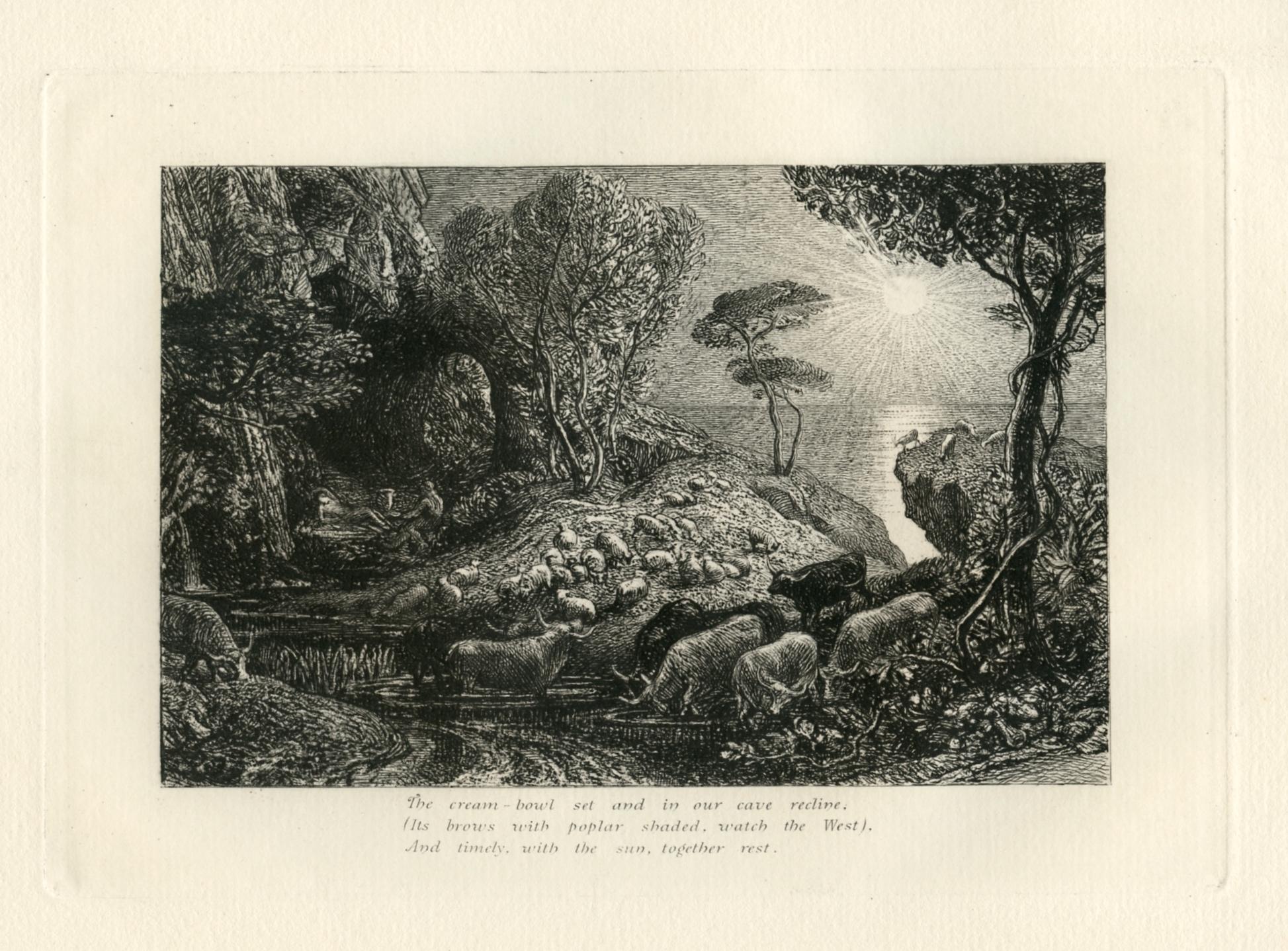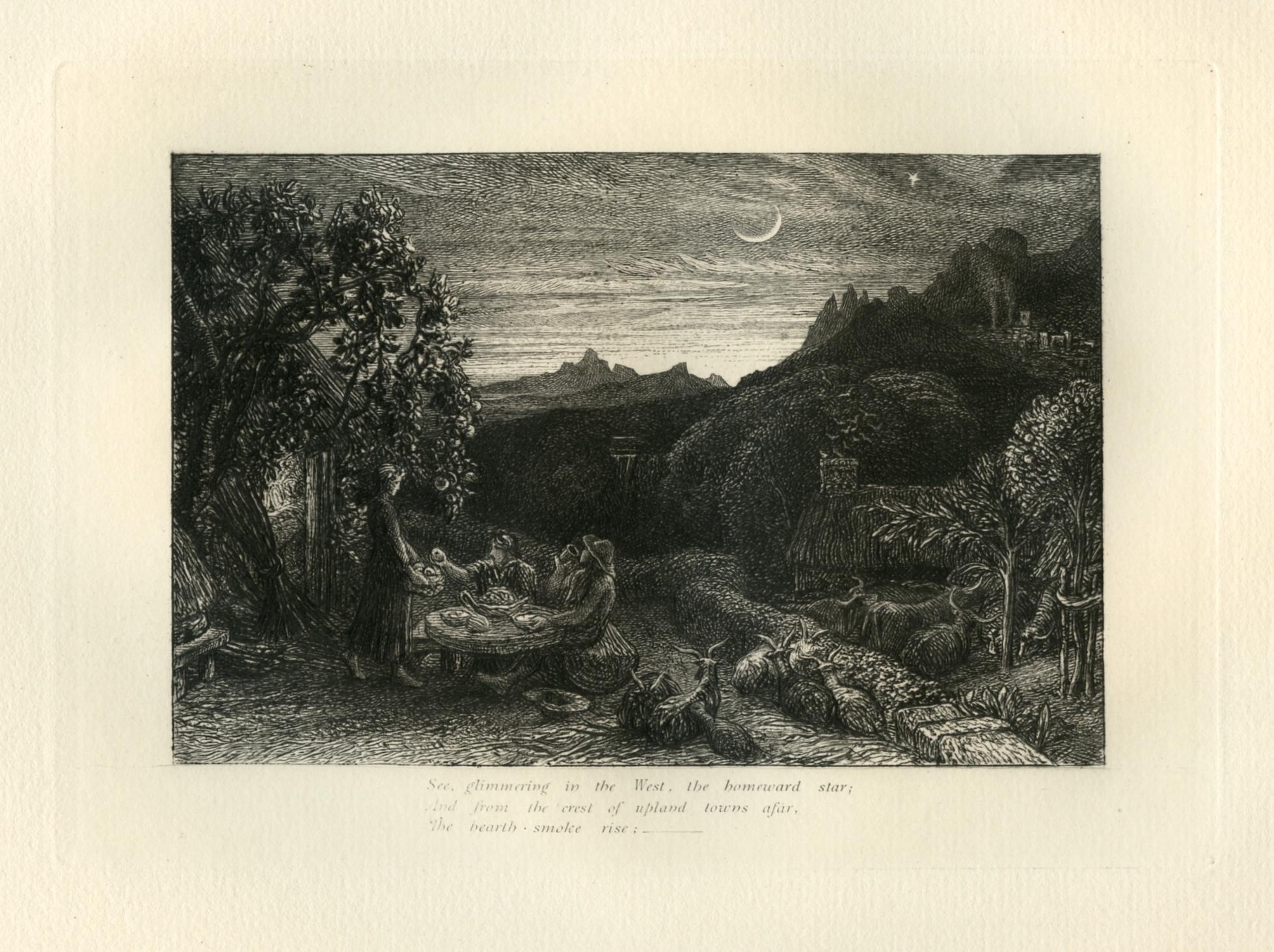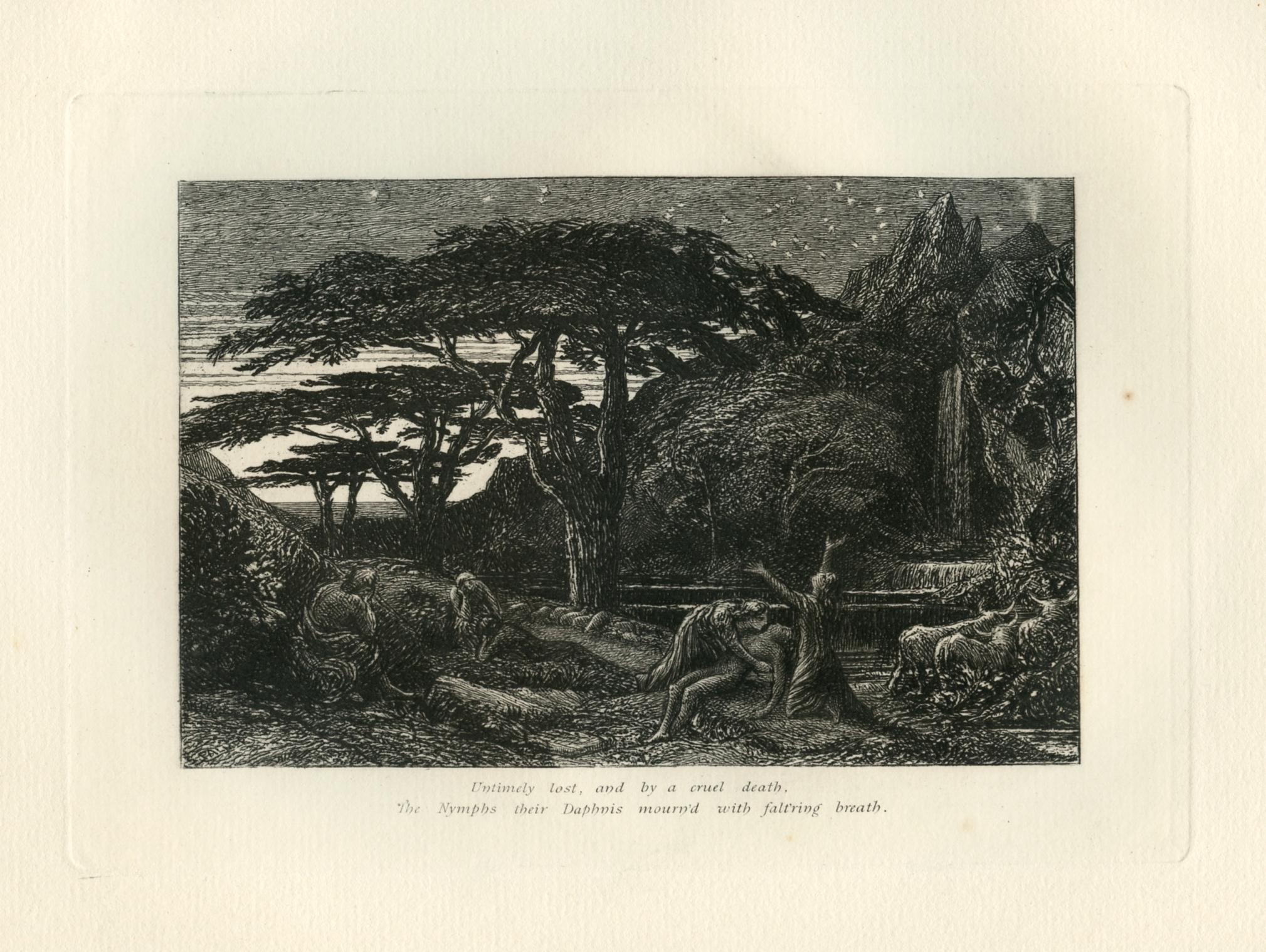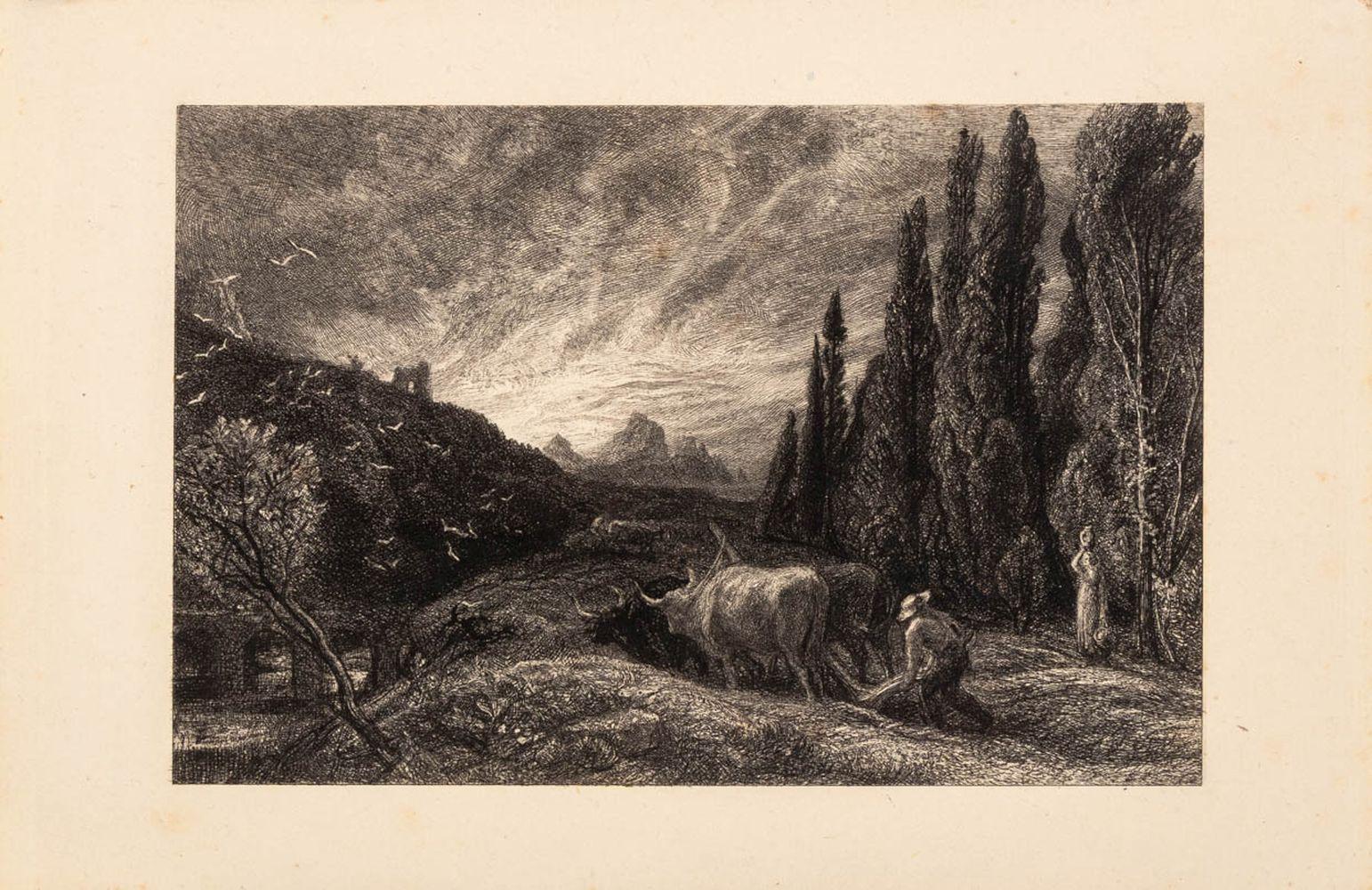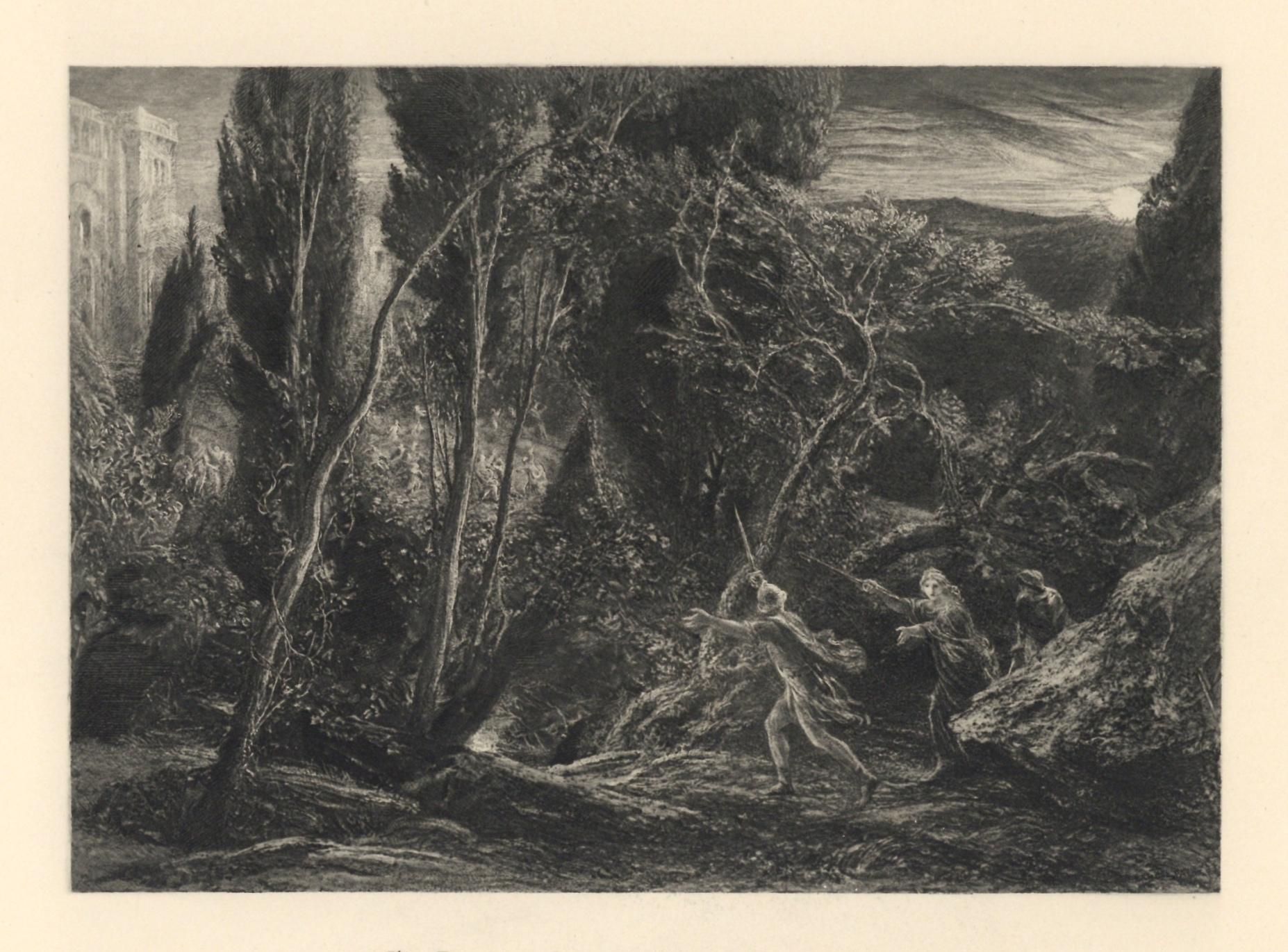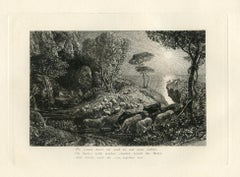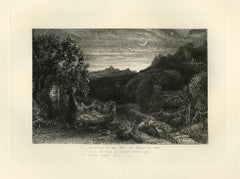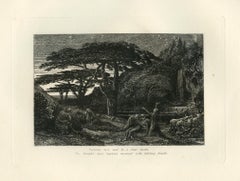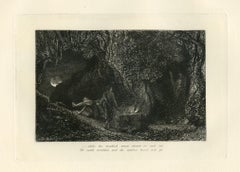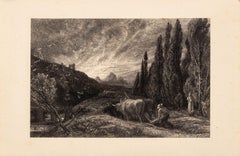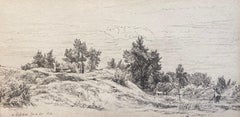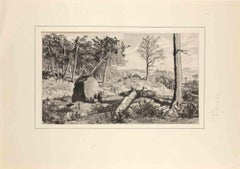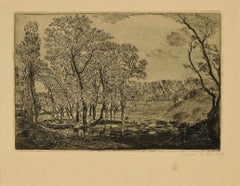Items Similar to "Opening the Fold - Early Morning" Eclogue 8 original etching
Want more images or videos?
Request additional images or videos from the seller
1 of 2
Samuel Palmer (b.1805)"Opening the Fold - Early Morning" Eclogue 8 original etching1883
1883
$1,000
£762.95
€872.48
CA$1,409.21
A$1,536.60
CHF 815.46
MX$18,576.95
NOK 10,320.19
SEK 9,459.89
DKK 6,516.53
About the Item
Medium: original etching. This impression on Alton Mill laid paper was printed in 1883 for "An English Version of the Eclogues of Virgil" and published in London by Seeley and Company. Samuel Palmer had planned a series of etchings to illustrate his translation of Virgil's Eclogues, but this etching is the only one he completely finished before his death in 1881. Catalogue reference: Lister E13. Image size: 4 5/8 x 7 inches (117 x 176 mm). Plate size: 6 x 8 3/8 inches (151 x 214 mm). Sheet size: 8 1/2 x 12 1/2 inches (215 x 317 mm). Signed in the plate (not by hand).
Condition: there is some foxing, plus age-toning near the edges of the sheet.
- Creator:Samuel Palmer (b.1805) (1805 - 1881, British)
- Creation Year:1883
- Dimensions:Height: 5.95 in (15.1 cm)Width: 8.43 in (21.4 cm)
- Medium:
- Movement & Style:
- Period:
- Condition:Condition: there is some foxing, plus age-toning near the edges of the sheet.
- Gallery Location:Henderson, NV
- Reference Number:1stDibs: LU2365216629062
About the Seller
5.0
Platinum Seller
Premium sellers with a 4.7+ rating and 24-hour response times
Established in 2006
1stDibs seller since 2023
588 sales on 1stDibs
Typical response time: 1 hour
- ShippingRetrieving quote...Shipping from: Henderson, NV
- Return Policy
More From This Seller
View All"Moeris and Galatea" Eclogue 9 original etching
By Samuel Palmer (b.1805)
Located in Henderson, NV
Medium: original etching. This impression on Alton Mill laid paper was printed in 1883 for "An English Version of the Eclogues of Virgil" and published in London by Seeley and Compan...
Category
1880s Realist Prints and Multiples
Materials
Etching
"The Homeward Star" Eclogue 1 original etching
By Samuel Palmer (b.1805)
Located in Henderson, NV
Medium: original etching. This impression on Alton Mill laid paper was printed in 1883 for "An English Version of the Eclogues of Virgil" and published in London by Seeley and Compan...
Category
1880s Realist Prints and Multiples
Materials
Etching
"The Cypress Grove" Eclogue 5 original etching
By Samuel Palmer (b.1805)
Located in Henderson, NV
Medium: original etching. This impression on Alton Mill laid paper was printed in 1883 for "An English Version of the Eclogues of Virgil" and published in London by Seeley and Compan...
Category
1880s Realist Prints and Multiples
Materials
Etching
"The Sepulchre" Eclogue 8 original etching
By Samuel Palmer (b.1805)
Located in Henderson, NV
Medium: original etching. This impression on Alton Mill laid paper was printed in 1883 for "An English Version of the Eclogues of Virgil" and published in London by Seeley and Compan...
Category
1880s Realist Prints and Multiples
Materials
Etching
(after) Samuel Palmer - "The Brothers discovering the Palace of Comus"
By Samuel Palmer (b.1805)
Located in Henderson, NV
Medium: photogravure (after the watercolor). Samuel Palmer had always admired the work of John Milton, and executed a suite of watercolors which were made into photo-engravings for "...
Category
1880s Realist Prints and Multiples
Materials
Photogravure
Eclogue 2 (after) Samuel Palmer
By Samuel Palmer (b.1805)
Located in Henderson, NV
Medium: heliogravure (after the drawing). This impression on Alton Mill laid paper was printed in 1883 for "An English Version of the Eclogues of Virgil" and published in London by S...
Category
1880s Realist Prints and Multiples
Materials
Photogravure
You May Also Like
"The Early Ploughman"
By Samuel Palmer (b.1805)
Located in Astoria, NY
Samuel Palmer (English, 1805-1881), "The Early Ploughman", Etching on Laid Paper, 1861, titled and inscribed "From Keppel Estate" to the verso, unframed. Image: 5" H x 7.75" W; sheet...
Category
1860s Landscape Prints
Materials
Laid Paper, Etching
A View Near Redhill, 19th Century Pen and Ink Drawing by Samuel Palmer
By Samuel Palmer (b.1805)
Located in London, GB
Pen and ink on paper, inscribed 'Redhill' and dated 'June 24th 1872' lower left
Image size: 4 x 8 inches (10 x 20 cm)
Mounted and Framed
Provenance
Given to Ernest Pearce by Carlos Peacock, from the collection of Miss Louisa Twining (1820-1911), a pupil of Samuel Palmer.
Carlos noted in his letter accompanying the work to Ernest Pearce that 'Going through my Palmer things for mounting the other day. I found this little sketch dating from the Redhill days. Thought you might like it by way of a Christmas gift'.
Literature
Carlos Peacock, Samuel Palmer , Shoreham and After, published by John Baker 1968, illustrated on page 67.
This delicate pen and ink drawing depicts a view at Redhill, a town in the borough of Reigate within the county of Surrey, England. While Palmer's reputation rests mainly on his Shoreham work some of his later work, such as his sketches from Redhill, have recently received more appreciation.
In 1872 Palmer was living in Redhill, at his last home, The Chantry at Cronks Hill. The Chantry is now Grade II listed due to the Palmer connection and Palmer Close, a cul-de-sac in Redhill (built in the 1960's), was also named in his honour.
This work is an illustration of rural paradise, a vision of the natural world where there is a cosmic harmony between man and his environment. Indeed, Alfred Palmer, the artist's son, wrote 'Had the artist depended for his material solely on the fields, and woods, and hills around him, and had he used that material in a sordid way, he might have given us faithful representations of those he selected, but there would have been inevitable repetition, and he would never have shown us as he has undoubtedly done, the very spirit and quintessence of the loveliest and most poetic pastoral scenery - scenery which we may imagine as that of ancient England...
Category
19th Century Landscape Drawings and Watercolors
Materials
Ink, Pen
Opus IV, Simplicius in der Waldeinode - Etching by Max Klinger - 1881
By Max Klinger
Located in Roma, IT
Opus IV, Simplicius in der Waldeinode (Simplicius in the Wilderness) belongs to a series of prints called Intermezzi realized by Max Klinger, published by Nurnberg: Stroefer, 1881.
...
Category
1880s Symbolist Figurative Prints
Materials
Etching
$1,076 Sale Price
25% Off
La Mare aux Peupliers - Original Etching by James Ensor - 1889
By James Ensor
Located in Roma, IT
Original etching realized by James Ensor in 1889.
Hand signed and dated. Good conditions, small stain lower right.
Image Dimensions : 15 x 23 cm
References: Delteil, Taevernier 74.
Category
1880s Modern Figurative Prints
Materials
Etching
Rome, Palatine Hill - Original Etching and Dry-point by Cesare Biseo - 1898
Located in Roma, IT
Rome, Palatine Hill is a wonderful etching and dry-point on paper by realized by Cesare Biseo in 1898.
Hand-signed and dated with the description on the lower in pencil.
In very go...
Category
1890s Figurative Prints
Materials
Drypoint, Etching
La Roxerie - Original Etching by Sir Francis Seymour Haden - 1867
Located in Roma, IT
La Roxerie is an original modern artwork realized by the English artist Sir Francis Seymour Haden (1818 – 1910) in 1867.
Original Etching on paper.
Signed and dated on plate on th...
Category
1860s Modern Landscape Prints
Materials
Etching
More Ways To Browse
Hawaiian Vintage Posters
Henri Matisse Linocut
Ian Phillips
Jean Cocteau Book
Jean English
Kasimir Landscape Etchings
Kaws Gone
Le Mans Car
Lenin Poster
Lido Poster
Lithograph Sailing
Marc Chagall The Blue Sky Signed
Michael Bigger
More Movie Poster
Native American Indian Prints
Norman Rockwell Signed Lithographs
Nuremberg Print
Oxford Poster
